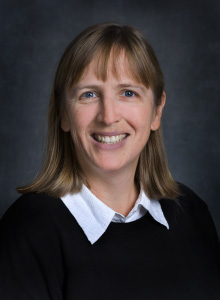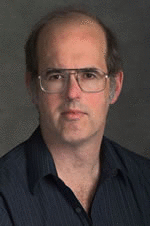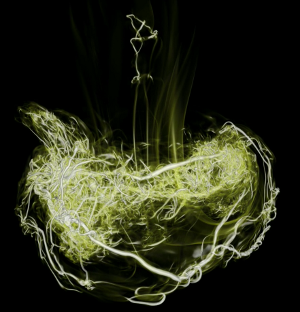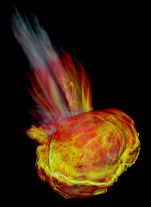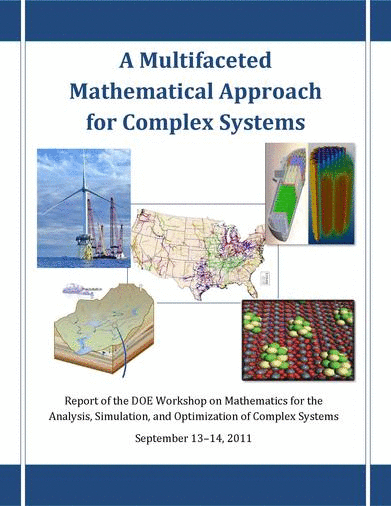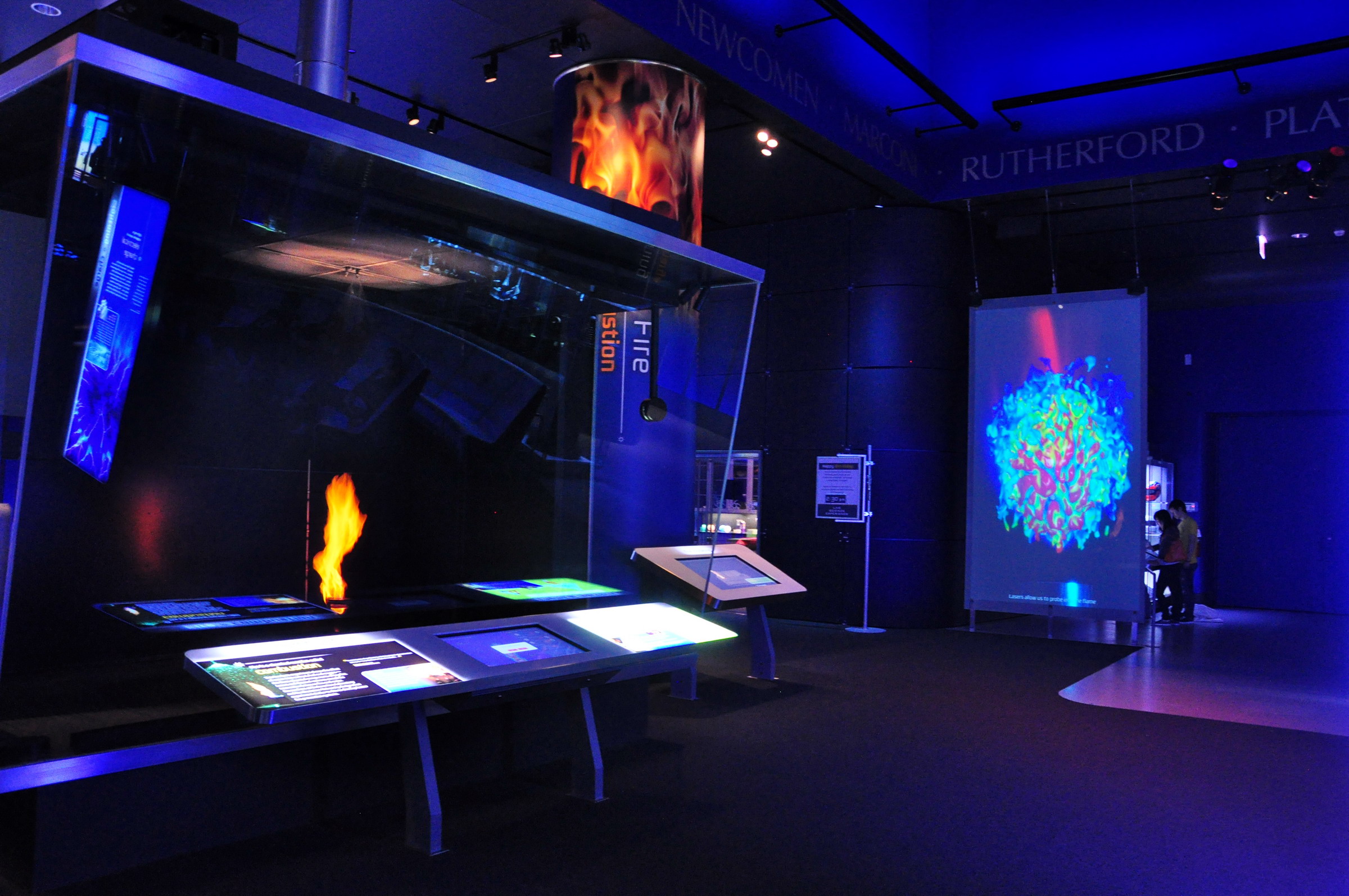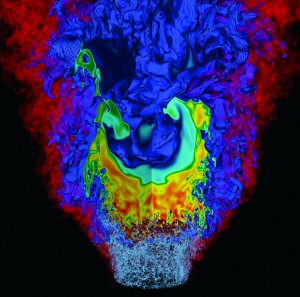
Home |
News |
Research |
Publications |
People |
BoxLib |
Links |
Downloads |
December 2012 News
Almgren Gives Invited Talk At Conference on Modeling the Earth SystemAnn Almgren gave an invited talk at the Frontiers in Computational Physics: Modeling the Earth System conference in Boulder, Colorado, on Monday, December 17. The talk was titled "Compressibility Effects in Low Mach Number Astrophysics," as was in a session called "How soundproof is the atmosphere?". In this talk Almgren described the connections between low Mach number models in atmospheric and astrophysical modeling. |
|
November 2012 News
|
Almgren Gives Invited Talk At SC12Ann Almgren gave a 45-minute invited talk at SC12 on Thursday, November 15, titled "Low Mach Number Models in Computational Astrophysics." In this talk Almgren described the motivation for, and development of, a low Mach number model to simulate low Mach number astrophysical phenomena, such as the convection in a white dwarf that precedes a Type Ia supernova. |
October 2012 News
Nonaka Featured in Symmetry Magazine Article"Andy Nonaka, an applied mathematician in the Center for Computational Sciences and Engineering at Lawrence Berkeley National Laboratory, works with visualizations for complex simulations. These simulations can require the supercomputing power equivalent to tens and hundreds of thousands of desktop computers, and the data from each time step can fill up hundreds of gigabytes of memory. The top supercomputers, such as the Hopper system at Berkeley Lab's National Energy Research Scientific Computing Center, complete quadrillions of calculations per second at peak operation, with the combined power of hundreds of thousands of processor cores. Nonaka's visualizations are typically less computing-intensive than simulations but can still require hundreds of computer processor cores to quickly render the graphics. Paired with advanced visualization software, all that memory has helped Nonaka's research team better understand the physics of Type Ia supernovae -- the largest thermonuclear explosions in the universe -- allowing for the visualization of three-dimensional contours and movies of how the star explodes. Just five years ago, 'most of our visualizations were of 2-D slices of data from a full 3D data set,' he says. " See the full article here.
|
|
|
Bell Gives UC Berkeley Math Department ColloquiumJohn Bell spoke at UC Berkeley's Math Department colloquium on Thursday, October 4; his talk was titled "Between Kinetic Theory and Navier Stokes - Modeling Fluids at the Mesoscale." In this talk he discussed recent work on the development and analysis of finite-volume methods for solving the equations of fluctuating hydrodynamics for miscible fluid mixtures. |
September 2012 News
|
CASTRO Simulation to Appear at Supercomputing 2012 Scientific Visualization ShowcaseResults from a CASTRO simulation will appear in the Supercomputing 2012 Scientific Visualization Showcase. The proceedings and animation are entitled, "Investigation of Turbulence in the Early Stages of a High Resolution Supernova Simulation". The animation was created by Robert Sisneros of NCSA using data provided by Chris Malone and Stan Woosley of UC Santa Cruz, and Andy Nonaka of CCSE using a Blue Waters Early Science System award. |
CASTRO Simulation Featured on the Cover of Access MagazineAn image from a recent Type Ia supernova post-ignition simulation using CCSE's CASTRO code is featured on the cover of Access Magazine, available here. The CASTRO simulation was performed by Chris Malone and Stan Woosley of UC Santa Cruz, and Andy Nonaka of CCSE, and used 24 Million CPU-hours from a Blue Waters Early Science System Award. This simulation ran on 64,000 cores and used 5 levels of AMR in order to realize an uprecedented ~100m resolution. Visualization courtesy of Robert Sisneros of NCSA. |
|
|
CASTRO Code Now Publicly AvailableAs part of the SciDAC-II Computational Astrophysics Consortium, members of CCSE, with contributions from several collaborators, developed CASTRO, a multi-dimensional Eulerian AMR radiation-hydrodynamics code that includes several equations of state, nuclear reaction networks, and self-gravity. There are currently three code papers describing CASTRO, and CASTRO has been used in a number of science publications by collaborators for simulations of Type Ia and Type II supernovae as well as Pair-Instability supernovae. Today CCSE is proud to make CASTRO publicly available via git at the CCSE Downloads page. CASTRO is based on the BoxLib software framework, which is also available at the CCSE Downloads page. |
July 2012 News
Bell Presents Two Talks at International Symposium on CombustionJohn Bell recently presented two talks at the 34th International Symposium on Combustion held in Warsaw, Poland, July 29 - August 3, 2012. The first talk was part of the 13th International Workshop on Premixed Turbulent Flames and was titled, "Simulation of Lean Premixed Low-Swirl Hydrogen Flames". The second talk was part of the main symposium and was titled "Simulation of Nitrogen Emissions in a Premixed Hydrogen Flame Stabilized on a Low Swirl Burner." |
|
|
Chaudhri Gives Invited Talk at BITC Annual SymposiumAnuj Chaudhri recently gave an invited talk at the Annual Symposium on 'Antibodies in Solution' at The Biomolecular Technologies Interaction Center at the University of New Hampshire. His talk was titled "Self Association of Therapeutic Monoclonal Antibodies:A Coarse-Grained Perspective on the Role of Electrostatics and More". |
Matt Emmett joins CCSE as New Postdoctoral FellowCCSE would like to welcome Matthew Emmett, our newest postdoc. He will be working on parallel-in-time and spectral deferred correction algorithms for compressible and low Mach number reacting flows. Matt received his PhD in Applied Mathematics from the University of Alberta in 2010. He has spent the last two years at the University of North Carolina, Chapel Hill, working with Prof. Michael Minion in the Applied Mathematics Department. He will be telecommuting from North Carolina for the next six months, and will join CCSE in person in January 2013. |
June 2012 News
|
|
Anuj Chaudhri joins CCSE as Postdoctoral FellowCCSE would like to welcome Anuj Chaudhri, our newest postdoc. He will be working on multiscale modeling methodologies, and specifically on numerical algorithms for stochastic partial differential equations. Over the last eight years, Chaudhri has worked extensively on different aspects of multiscale methods and stochastic processes. As a University of Pennsylvania graduate student in Applied Mechanics and Mechanical Engineering, he applied these methodologies to atomistic and mesoscopic particle-based methods in physics. Then as a postdoctoral scholar at the University of Chicago, he applied his expertise to systematic multiscale models for biological systems. "I came to CCSE to learn a different approach to modeling physical and biological systems, and to see how or if these different approaches converge," says Chaudhri. A native of India, Chaudhrij came to the U.S. to pursue a Masters degree at the University of Tennessee. It was here that he discovered his passion for theoretical physics and math, as well as computing sciences. In his spare time, Anuj enjoys hiking, photography and reading. |
May 2012 News
John Bell Elected to the National Academy of SciencesOn May 1, 2012, the National Academy of Sciences announced its 84 newly elected members and 21 foreign associates, spanning fields such as anthropology, economics, biology, chemistry, physics and mathematics. John Bell was one of four Berkeley Lab researchers, and one of only two mathematicians, on this year's list. The NAS membership is one of the highest honors given to a scientist or engineer in the United States, and recognizes the electees' distinguished careers and research accomplishments. Read more here. |
|
March 2012 News
|
|
DOE Math Report Calls for Paradigm Shift in Applied Math ResearchThe Report of the DOE Workshop on Mathematics for the Analysis, Simulation, and Optimization of Complex Systems, of which CRD's John Bell and David Brown are co-authors, has just been released by DOE. The report, titled A Multifaceted Mathematical Approach for Complex Systems, identifies several priority research directions for DOE-funded mathematics, and comments that the type of research activities envisioned for multifaceted mathematics represents a paradigm shift from the traditional single-investigator model for applied mathematics research... This type of paradigm shift will enable applied mathematicians to make a significant impact on scientific and engineering challenges that face DOE. |
MAESTRO Simulations Now Available on You TubeThe first of several MAESTRO movies has now made its way onto You Tube, under the title MAESTRO simulation of white dwarf convection in Type Ia supernova (576^3). |
|
|
|
CCSE Awarded Blue Waters Early Science Program Allocation |
LMC Simulation Shown at the Chicago Museum of Science and IndustryAs part of a Fire exhibition, an animation of a LMC (Low Mach number Combution) simulation is being shown on two large screens at the Chicago Museum of Science and Industry. |
|
February 2012 News
|
|
Bell and Fagnan Featured on AMS WebsiteCCSE's very own John Bell and Kirsten Fagnan, neither of whom are in fact faculty, are featured on the AMS web site titled "Information for Faculty." Click here to see the AMS site. |
January 2012 News
CCSE Combustion Research Featured in CRT AnnouncementCCSE combustion research is one of three featured applications in the latest LBNL handout describing the new Computational Research and Theory (CRT) Facility. The other two applications are global climate change and clean, renewable energy. The caption for the combustion blurb, titled "Increasing Energy Efficiency," reads, |
|
Archive
 |
|
 |
